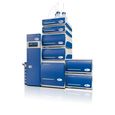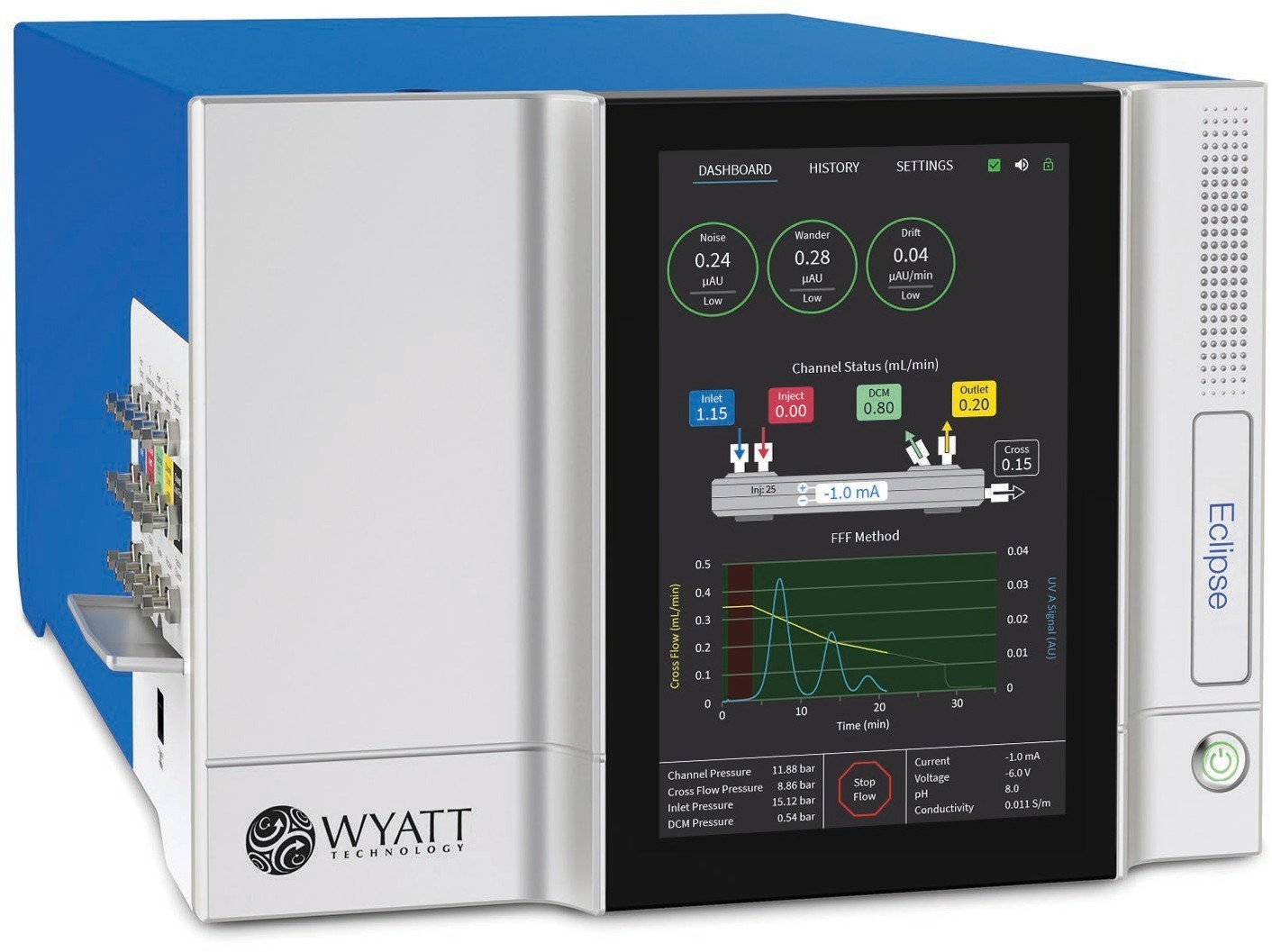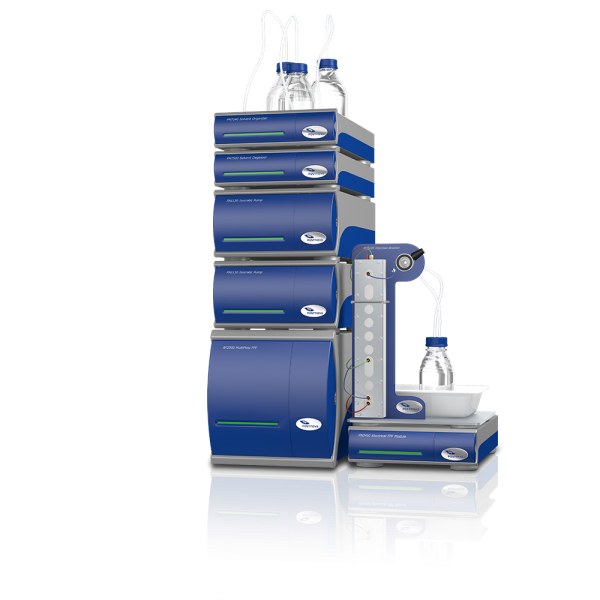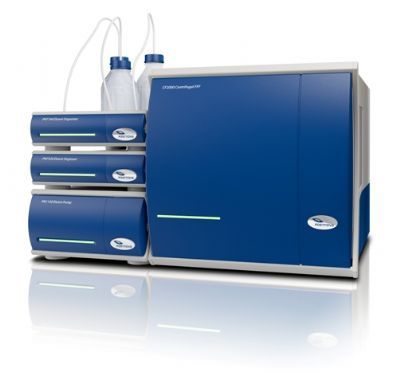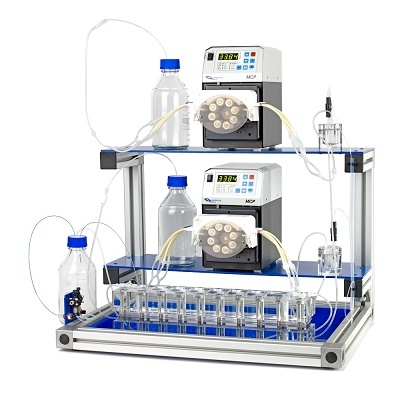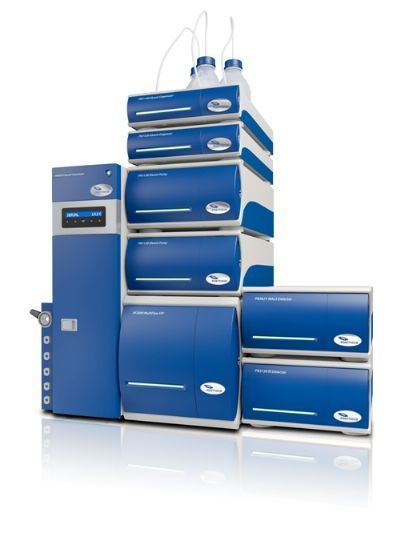
富勒烯C60是环境领域常用的一种纳米材料。postnova的AF2000AT/MT仪器,能够很好地完成C60的尺寸分布测试,结合在线动态光散射激光粒度仪,还可以测试其绝对尺寸。进一步地,还可以与ICP-MS等仪器在线联用。
方案详情

References: 1) Burangulov 2006 2) Woodrow Wilson Center,Project on Emerging Nanomaterials, 2001 3) Guildi 2002 4) Kim 2006 5) Tagmatarchis,2001 6) National Nanotechnology Initiative, 2006 7) EPA Nanotechnology White Paper 2007 8) Brant, 2005 9) Xie, 2008 10) Size Determination of Aqueous C6o Colloids by Asymmetric Flow-FieldFlow Fractionation (AF4) and in-Line Dynamic Light Scattering Carl Isaacsons, Xin (Cissy) Mat and Dermont Bouchard t',t National Research Council Research Associates US Environmental Protection Agency, National Exposure Research Laboratoryt, 1. Abstract A size separation method was developed foraqueous C6o fullerene aggregates (aqu/C60)using asymmetric flow field-flow fractionation(AF4) coupled to a dynamic light scattering(DLS) detector in flow through mode.Surfactants, which are commonly used inAF4, were avoided as they may altersuspension characteristics. Aqu/Csoaggregates generated by sonication indeionized water ranged in hydrodynamicdiameter (D,) from 80-260 nm as determinedby DLS in flow through mode. Sizeobservations were confirmed by DLS (batchmode) and TEM techniques. The mass ofC6o in each fraction was determined by LC-APPI-MS. Of the total aqu/C60 mass, only7.7±6.9% had D, less than 80 nm, while58±32% had D, between 80-150 nm and14±9.2% were between 150-260 nm in D..With the optimal fractionation parameters, 79±5.7% of the aqu/C6o mass eluted from theAF4 channel, indicating deposition occurredduring fractionation. Use of alternativemembranes did not reduce deposition.Channel flow splitting increased detectorresponse,although not to the degreepredicted by theory. This is the first report ofthe high resolution size determination ofaggregated aqu/Co. ll.Background ·Fullerenes are a widely used nanomaterial 1.2,3,4.5 ·Concern is growing over the impact a potential releaseof fullerenes may have on human andenvironmental health6,7 · Aqueous suspension of nanometer sized fullereneaggregates can be formed by sonication, extendedstirring and solvent exchange 8.9,10 ·Current light scattering techniques are limited by poorresolution and sample heterogeneity·Microscopy techniques are not suitable for large sample sizes and are prone to artifacts10·AF4 is used to size separate polydisperse particlepopulations11· In normal mode, AF4 can separate particles from 1 to 500 nm in diameter11 ·Elution conditions can vary with ionic strength andsurfactant type11 ·AF4 coupled in-line with light scattering detectorsallows for simultaneous size fractionation, detection and size determination of polydisperse colloids12 Ⅲ.AF4 Size Separation ·In AF4 two flow streams effect separation:the cross flow forces particles against theaccumulation membrane ·the channel flow sweeps particles to detector·Small particles with large diffusion coefficients, diffusefurther into the channel than large particles withsmall diffusion coefficients ·In the parabolic channel flow, small particlesexperience a greater channel velocity than largeparticles ·Small particles elute before large particles I.Objectives ·Develop an AF4 size separation method for aqu/C60based on DIHO eluent·Determine the C6o mass distribution within the aqu/C60size distribution·Determine effect of different membrane type and injection volume on fractionation efficacy V. Experimental ·AF4 (AF 2000,Postnova, Salt Lake City, UT) coupled in-line to a DLS (Malvern, Westborough,MA) ·Used 50, 100,500,1000,2000 pL injection volumes·Membranes included cellulose acetate (10 kDa),polyethersulfone (10 kDa), polypropylene (30 nm) and polycarbonate (10 nm)·Fractions were collected every two minutes and themass of C6o in each fraction was determined by liquidchromatography-atmospheric pressurephotoionization-mass spectrometry (LC-APPI-MS) Athens GA, USA Corresponding author phone: (706)355-8333; email: bouchard.dermont@epa.gov VI. Results and Discussion 1B 0 80- 300 w 200 SC 100 4Uw SamipleInjectior & Focu Time (min) Figure 1A, AF4 fraction of aqu/C60 at a cross flow of 1 mL/min, channel flow 1 mL/min, with size determination by DLS indicates aqu/C6o elute in order ofincreasing size with D,ranging from 110-200 nm. Figure 1B, fractions collected at two minute intervals (·) indicate that 13±2.2% have D, less than110 nm,50±32% have D, between 110-150 nm and 17±20 % have D,between 150-200 nm. Deposition was observed as 81±5.8%(m) of theaqu/C6o eluted from the AF4 channel. Time (min) Figure 2A, Increased cross flow of 2 mL/min and channel flow 1 mL/min provides greater resolution and indicates aqu/Cso aggregates ranged from 80-200 nm in D. Figure 2B, fractions collected at two minute intervals (·) indicate that 8.3±1.5 % of the aqu/C6o have D, less than 80 nm,57±26%have D,between 80-130 nm and 14±11 % have D, between 130-200 nm. Deposition did not increase as 83±11 %(m) of the aqu/C6o eluted fromthe AF4 channel. : 300 150 3B 250 20001 器 .. 150 Spo.100 50 40- = Hydrodynamic diameter ofaqu-C (flow through mode)Hydrudynamnic diameier of aqu-Can (baicit mode) Figure 3A, Fractionations at a cross flow of 4 mL/min and channel flow 1 mL/min providegreater resolution, indicate aqu/C6o aggregates range from 80-260 nm in D.. Figure 3 B,fractions collected at two minute intervals (·) indicate that 7.7±6.9% of the aqu/C6o haveD, less than 80 nm, 58±32% have D, between 80-140 nm and 14±9.2% have D,between 130-260 nm. Increased deposition was observed as 79±5.7%() of theaqu/C6o eluted from the AF4 channel. Size determinations were verified by batch analysisby DLS (3A) and TEM (3 D-G). 100- Figure 4, percent of VIl. Conclusions aqu/C6o that eluted With the 4 mL/min cross flow fractionation program, aqu- from the AF4 80- channel upon ·Ranged in D, from 80-260 nm injection of varying ·Only 7.7±6.9 % of the total aqu/C6o mass had D, lessw amounts aqu/Cso 60- Achieving high recoveries at large injection volumes 40- and low recoveries at low injection volumes indicates a 060than 80 nm·58 ±32% of the total aqu/C60 mass had D, between 80-150nm·14±9.2 % of the total aqu/C6o were between 150-260nm in D, ·Deposition was observed as 79±5.7 % of the aqu/C60eluted from the AF4 channel 20- limited number of sorption sites for VIII. Acknowledgements aqu/C6o 0- 0 500 1000 1500 2000 Injection Volume (uL) ·Jean-Luc Brousseau (Malvern Instruments) and Solheyl7Tadjiki (Postnova Analytics) for their helpful insights,·Haijun Qian (Clemson Electron Microscopy Facility) for hishelp collecting TEM images and Susan Richardson (EPA,Athens) for use of the LC-MS, ·Sung Gung Lee, Bethany Wigington, and Tantiana Burnsfor the assistance and good humor they provided overthe course of this study Although this work was reviewed by EPA and approved for presentation, it may not necessarily reflect official Agency policy. Mention of trade
确定
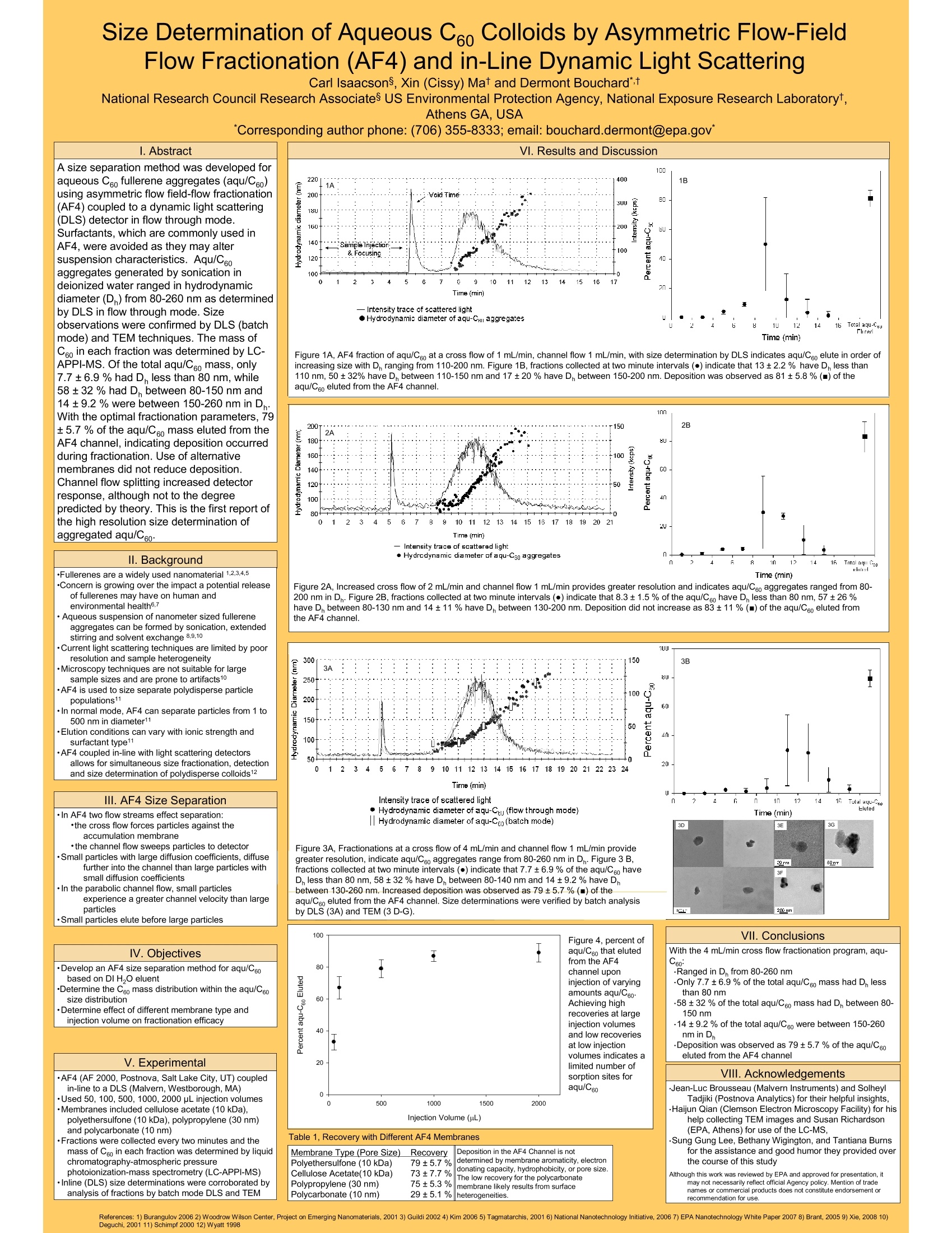
还剩1页未读,是否继续阅读?
上海积利科学仪器有限公司为您提供《富勒烯C60中尺寸分布检测方案 》,该方案主要用于其他中其他检测,参考标准--,《富勒烯C60中尺寸分布检测方案 》用到的仪器有非对称流动场场流分离仪
相关方案
更多
该厂商其他方案
更多








